Our verdict
- Top pick in best Jordan basketball shoes
- Top pick in best basketball shoes with a wide toebox
Pros
- High energy return from ZoomX
- Premium-level outsole traction
- Fantastic lateral stability (nothing like the AJ39!)
- Highly secure foot containment
- Excellent durability
- Solid medium-width fit
- Visually appealing
Cons
- Surprisingly low shock absorption
- One of the heaviest hoop shoes
- Non-breathable, toasty upper
- Not for outdoor courts
Audience verdict
- Top 4% most popular basketball shoes
Comparison
The most similar basketball shoes compared
+ + Add a shoe | |||||
|---|---|---|---|---|---|
| Audience score | 83 Good! | 89 Great! | 80 Decent! | 89 Great! | |
| Price | $205 | $200 | $145 | $190 | |
| Signature | Michael Jordan | Michael Jordan | Zion Williamson | - | |
| Shock absorption | Low | High | High | Moderate | |
| Energy return | Moderate | High | High | High | |
| Traction | High | Moderate | Moderate | Moderate | |
| Top | Low | Low | Low | Low | |
| Ankle support | ✓ | ✓ | ✓ | ✓ | |
| Weight lab | 15.5 oz / 439g | 13.9 oz / 394g | 14.4 oz / 408g | 11.8 oz / 335g | |
| Lightweight | ✗ | ✓ | ✗ | ✓ | |
| Breathability | Warm | Warm | Moderate | Warm | |
| Outsole durability | Decent | Good | Good | Good | |
| Drop lab | 4.9 mm | 7.2 mm | 6.5 mm | 5.5 mm | |
| Heel stack lab | 25.4 mm | 27.1 mm | 25.2 mm | 27.0 mm | |
| Forefoot | 20.5 mm | 19.9 mm | 18.7 mm | 21.5 mm | |
| Size | Half size small | True to size | Half size small | True to size | |
| Midsole softness | Soft | Soft | Balanced | Soft | |
| Stiffness | Moderate | Moderate | Flexible | Stiff | |
| Torsional rigidity | Stiff | Moderate | Stiff | Stiff | |
| Heel counter stiffness | Moderate | Flexible | Moderate | Flexible | |
| Width / fit | Medium | Medium | Medium | Medium | |
| Toebox width | Wide | Wide | Narrow | Medium | |
| Midsole width - forefoot | Average | Narrow | Average | Average | |
| Midsole width - heel | Narrow | Narrow | Very narrow | Narrow | |
| Heel padding durability | Good | Decent | Decent | Bad | |
| Toebox durability | Decent | Decent | Decent | Decent | |
| Insole thickness | Average | Average | Average | Average | |
| Outsole hardness | - | Average | - | Hard | |
| Outsole thickness | Average | Average | Average | Average | |
| Heel tab | None | None | None | None | |
| Ranking | #42 Bottom 20% | #19 Top 36% | #48 Bottom 9% | #17 Top 33% | |
| Popularity | #2 Top 4% | #10 Top 19% | #28 Bottom 47% | #1 Top 2% |
Who should buy
Considering its price point, the 40th Air Jordan is a big investment for sure. But we believe that it will be money well spent if:
- you are a huge fan of Michael Jordan and his shoe line
- you want a shoe that packs Nike's top-notch materials and technologies
- you prefer dynamic hoop shoes with high energy return
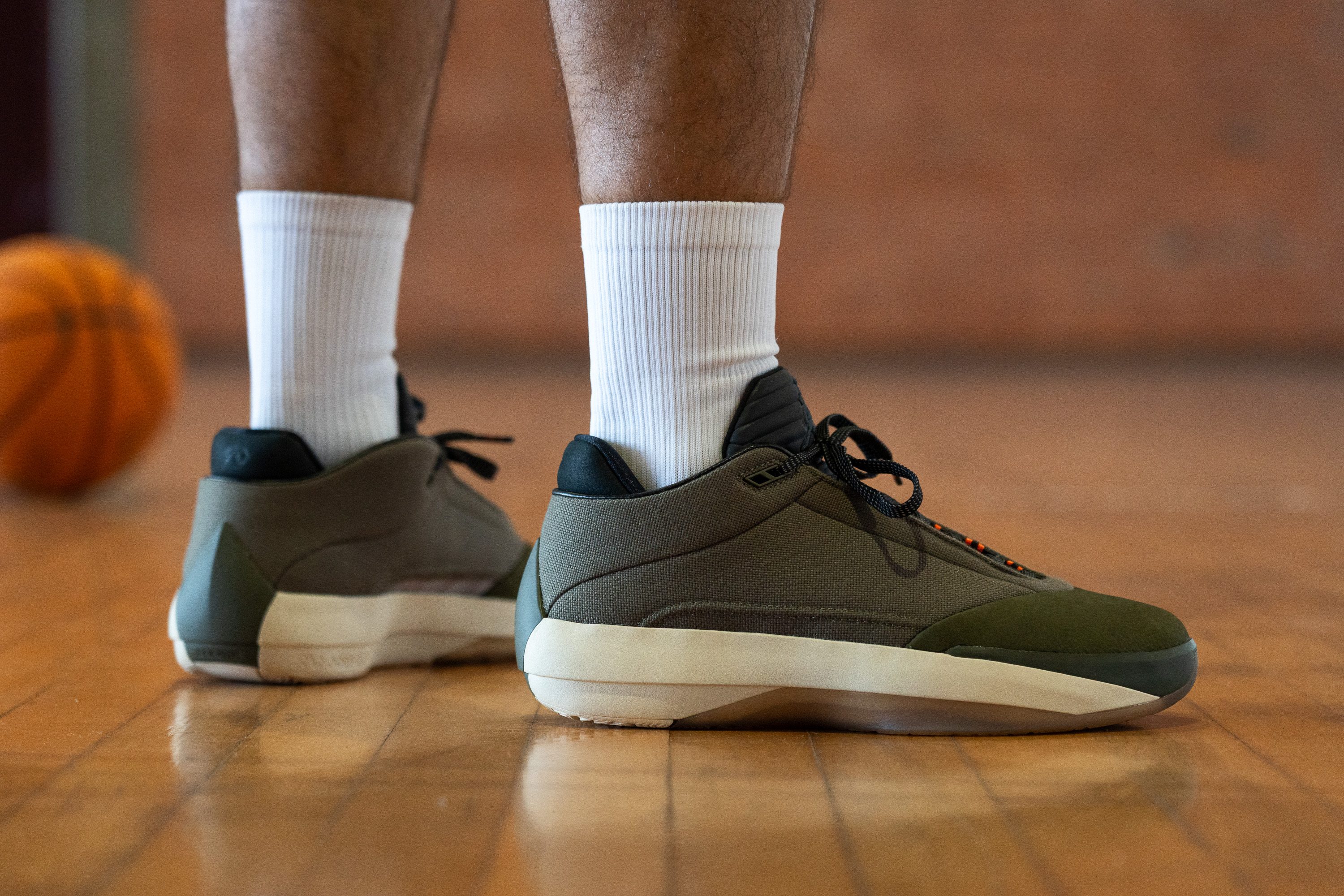
Who should NOT buy
If you are a lighter player or a guard who struggles to make peace with the AJ40's heavy weight but wants the benefits of its explosive ZoomX foam, you may find the Nike G.T. Cut 3 Turbo a much better alternative for you, as it weighs only 12.6 oz (357g)!
Another major reason to look away from the Air Jordan 40, in our opinion, is its perplexingly low shock absorption. Bigs, centers, and players with past injuries who want to show their joints more love should consider the Nike LeBron 23 instead.
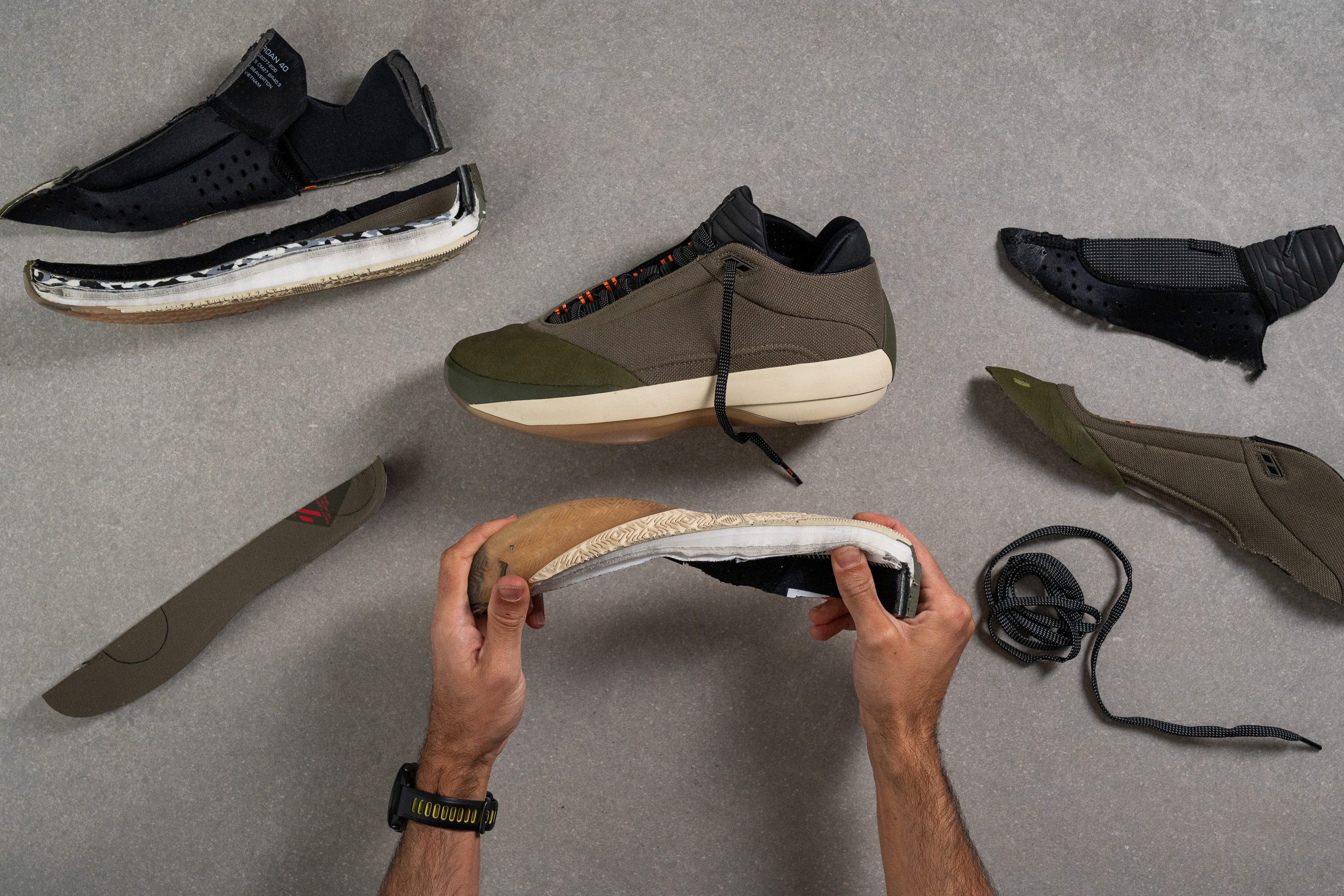
Cushioning
Shock absorption
Nike promises 'marathon-level cushioning' in the AJ40, which can trick you into thinking it is a max-cushioned hoop shoe with plenty of impact protection, which makes all four quarters feel like a breeze.
But our lab tests showed that this couldn't be further from the truth!
Measuring the shoe's shock absorption in both the heel (87 SA) and the forefoot (47 SA), we recorded some of the lowest readings among basketball shoes ever! Even the minimal Sabrina 3 offers notably more underfoot cushioning (96 SA/74 SA)!
This Air Jordan shoe is not the best choice for bigger players and those looking for solid joint protection.
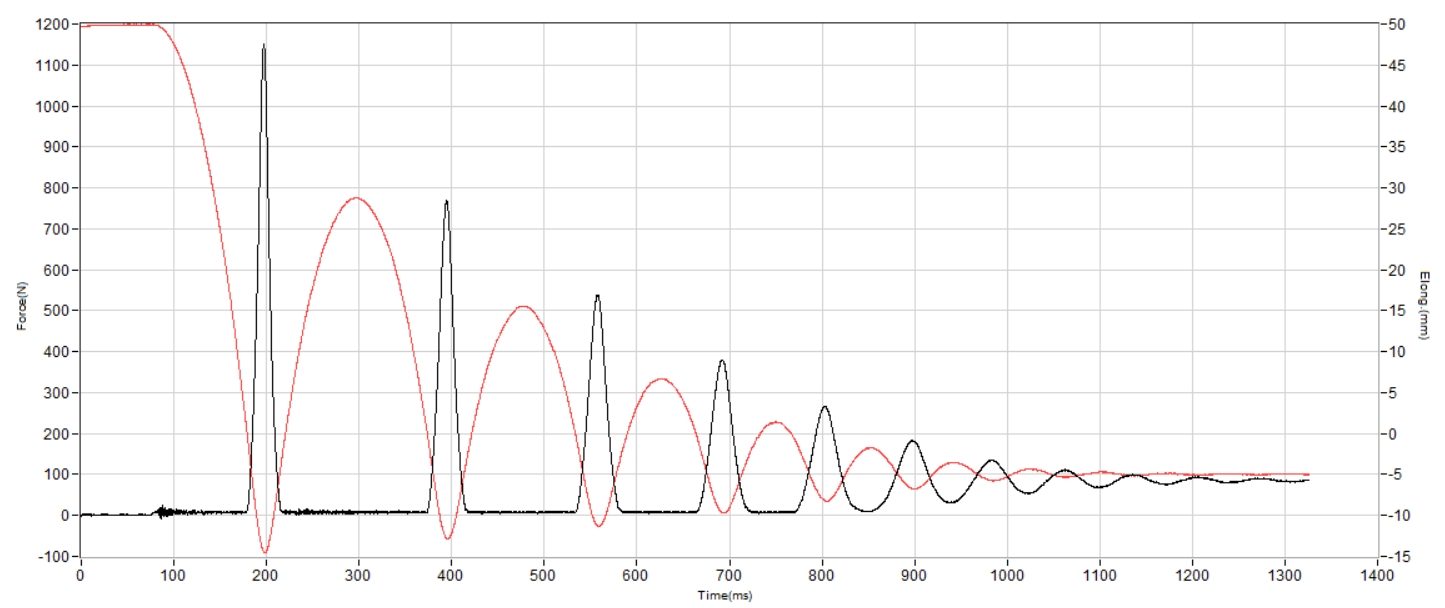
| Air 40 | 87 SA |
| Average | 103 SA |
Energy return
However, the key strength of this AJ shoe lies in its highly responsive and even explosive nature.
A potent mix of Nike's most advanced ZoomX foam and a full-length Zoom Strobel feels exceptionally dynamic underfoot! Their power is reflected in our energy return measurements, exceeding the average in both the heel (64.6%) and forefoot (63.6%) of the shoe.
But is it the most propulsive basketball shoe in our lab? In fact, it is not. The Nike G.T. Cut 3 Turbo showed some of the highest readings (71.5% and 83.2%) in this test, followed by the Nike LeBron 23 (70.4% and 72.1%). Both shoes feature Nike's ZoomX foam as well.
P.S. According to Nike, ZoomX offers 'an 85 percent energy return,' but their testing method is not specified. In our lab, we follow the industry's acclaimed ASTM F1976 protocol for testing both shock absorption and energy return.
| Air 40 | 63.6% |
| Average | 62.1% |
Heel stack
It may not seem like it from the outside, but the Air Jordan 40's stack height is actually on par with the Nike Sabrina 3! That's how important it is to cut shoes in half to get the real numbers.
Our caliper measured its heel stack at 25.4 mm, which is notably lower than the average for basketball shoes.
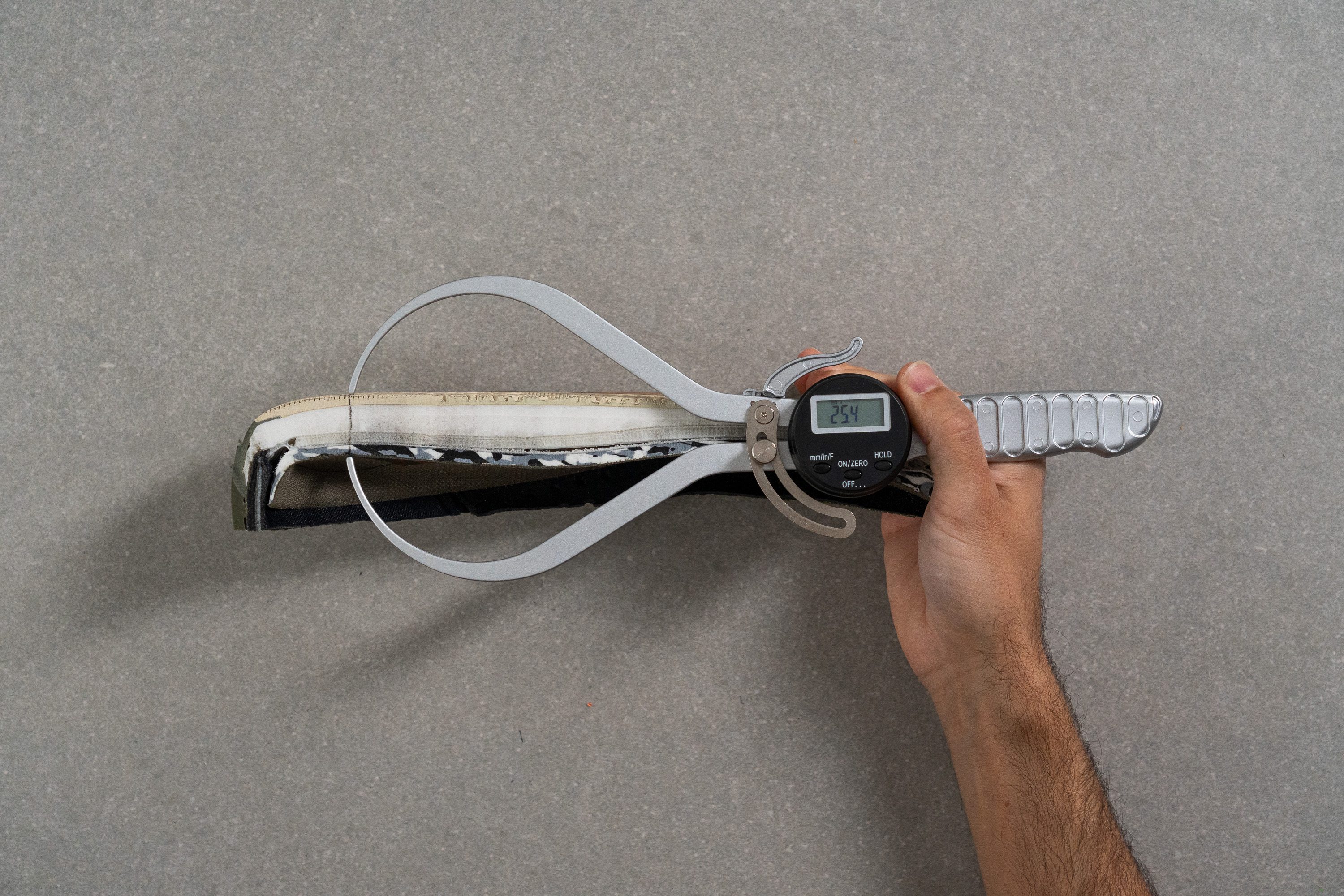
| Air 40 | 25.4 mm |
| Average | 28.8 mm |
Forefoot stack
The shoe's forefoot stack also measured a moderately low reading of 20.5 mm.
This could lead us to conclude that the AJ40 has a pronounced court feel, but that's not the case. The soft and responsive nature of its ZoomX cushioning mutes out the underfoot experience.
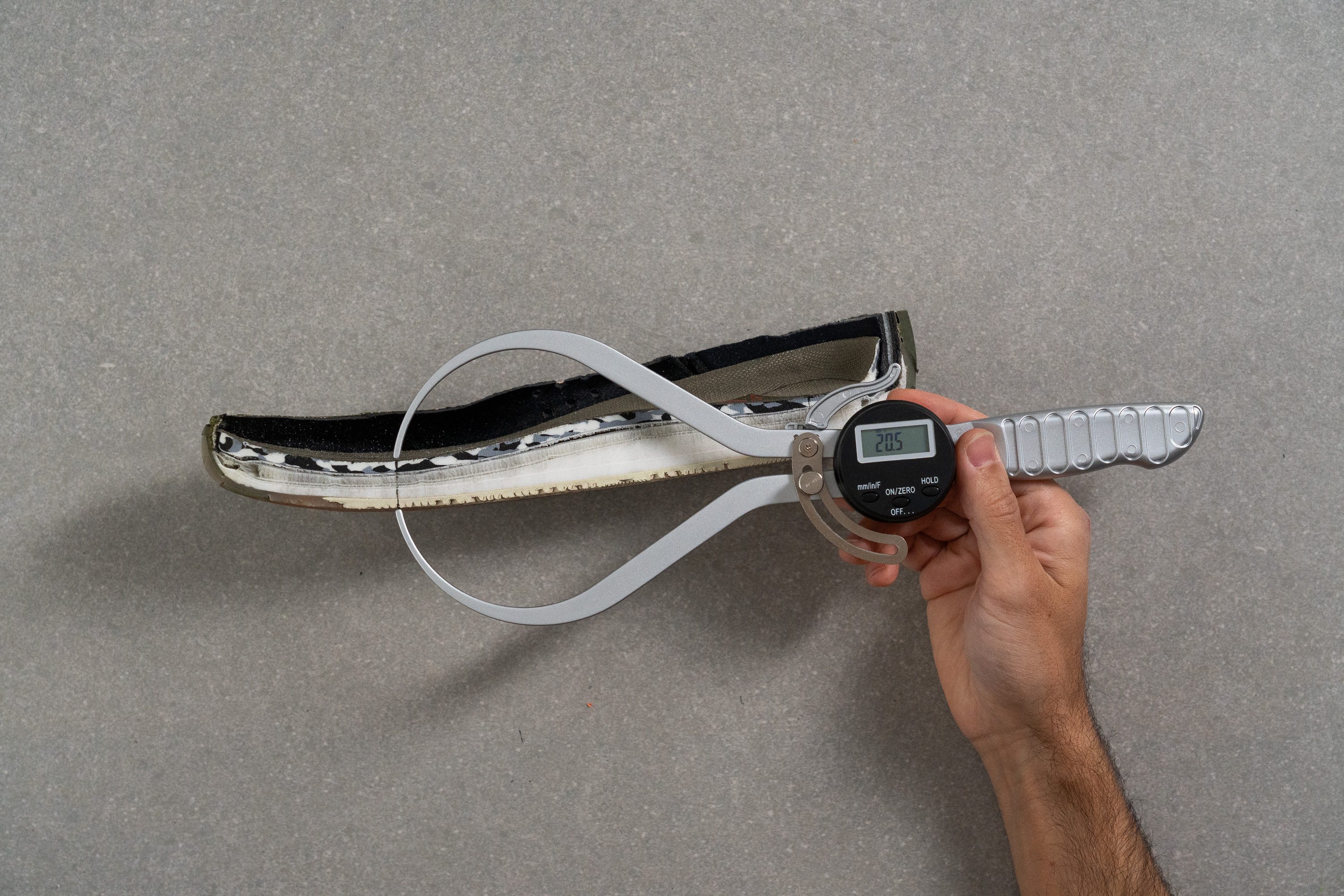
| Air 40 | 20.5 mm |
| Average | 21.4 mm |
Drop
With a moderate drop of 4.9 mm, the AJ 40 offers a more gradual heel-to-toe positioning, putting the foot more leveled with the court.
There is less of that forward pitch that you can feel in hoop shoes with a higher offset. But in return, you get a more stable and planted footing with more even weight distribution.

| Air 40 | 4.9 mm |
| Average | 7.4 mm |
Midsole softness
As expected, the ZoomX compound itself has a very plush nature. Pressing our durometer against the foam returned an exceptionally low reading of 15.5 HA.
But don't worry, wobbling is not part of the deal thanks to the tough rubber caging around the foam.
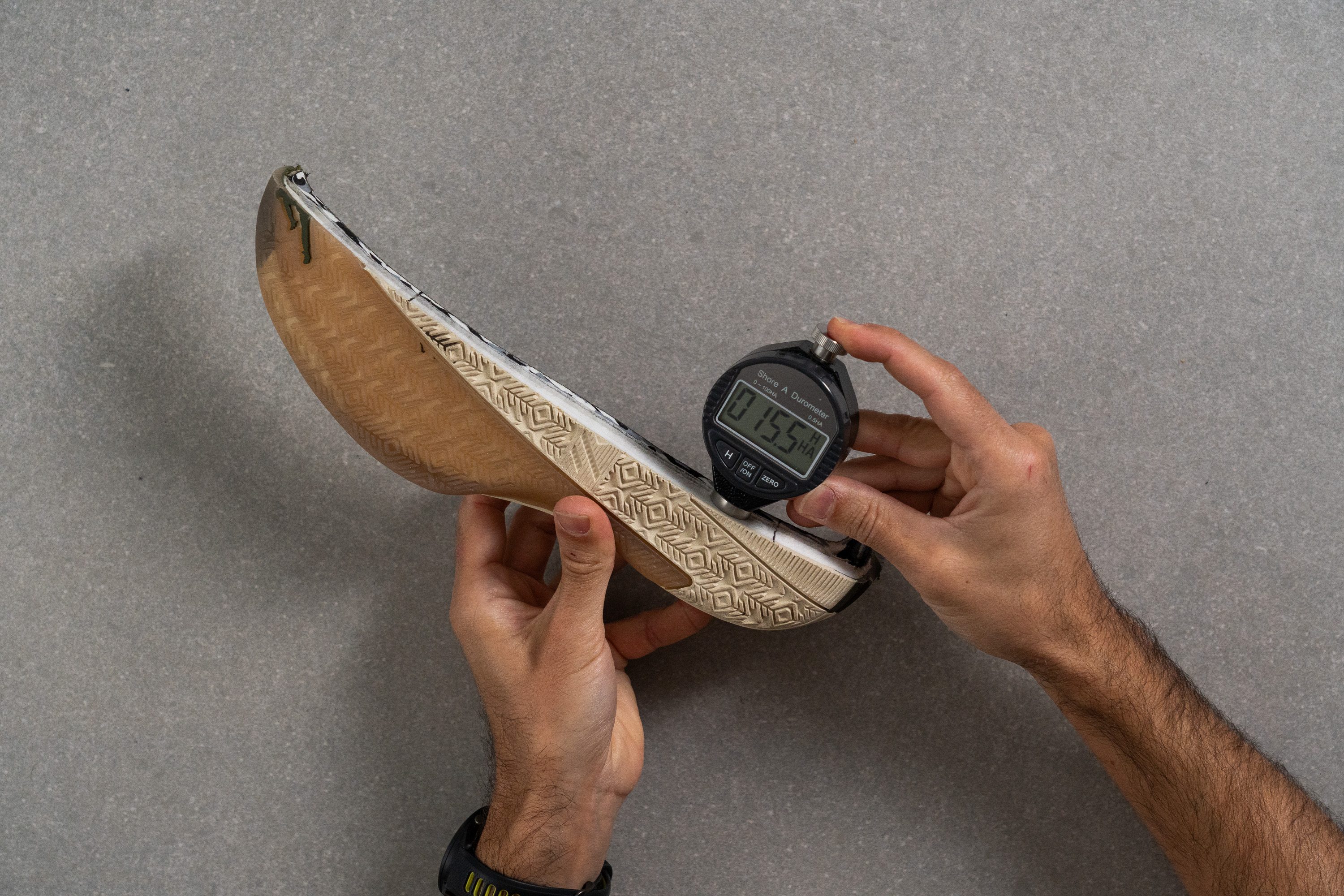
| Air 40 | 15.5 HA |
| Average | 24.3 HA |
Size and fit
Size
Air Jordan 40 fits half size small (42 votes).
Consider sizing up
Width / Fit
The unforgiving nature of the Air Jordan 40's upper materials makes it even more critical to get the right fit without relying too much on a break-in period.
Having filled the shoe's forefoot with custom gel, we waited until it stiffened in the form of the interiors. Once the gel mold was ready, we measured its dimensions with a digital caliper.
The widest part of the AJ40 (the ball of the foot area) showed a solid medium-width reading of 93.4 mm.
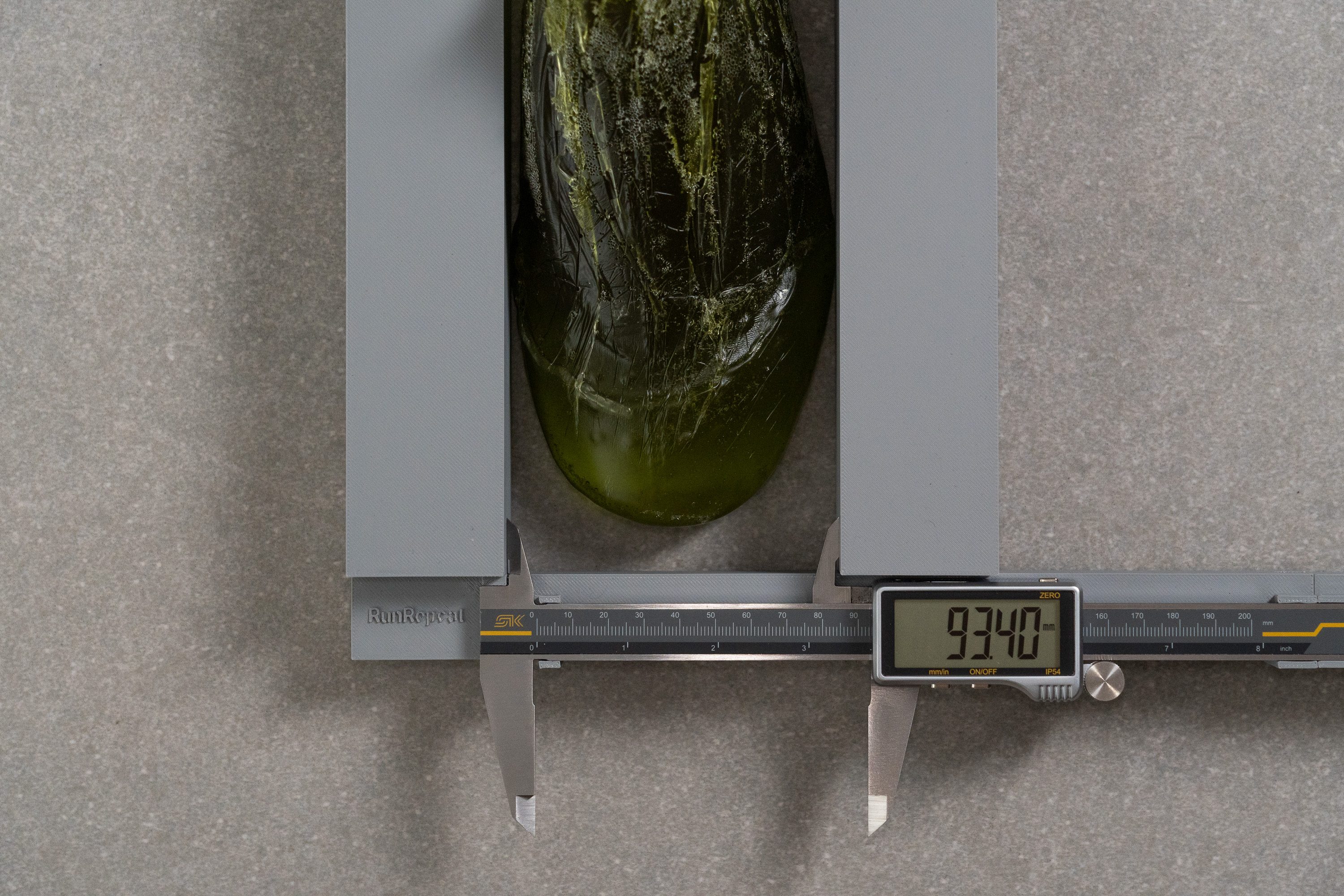
| Air 40 | 93.4 mm |
| Average | 92.8 mm |
Toebox width
We observed no sharp narrowing of the upper toward the toes either.
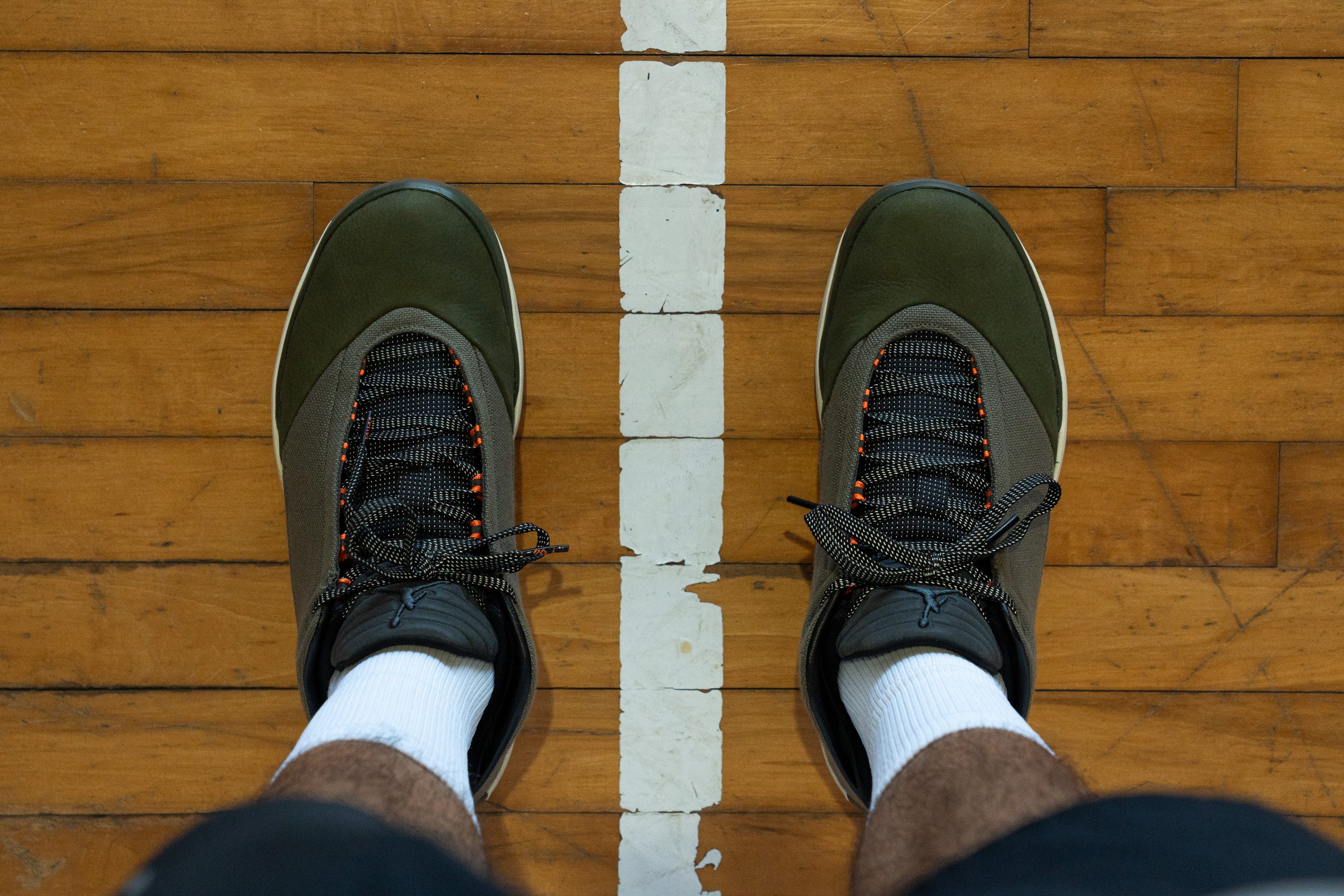
With an above-average width of 71.9 mm in the big toe area, this Air Jordan shoe offers sufficient toebox space for a medium-width foot.

| Air 40 | 71.9 mm |
| Average | 69.3 mm |
Toebox height
We were also pleased to find that the shoe's tough toebox leather didn't press against our toes from the top.
In fact, the shoe's toebox height turned out to be above average at 27.3 mm.
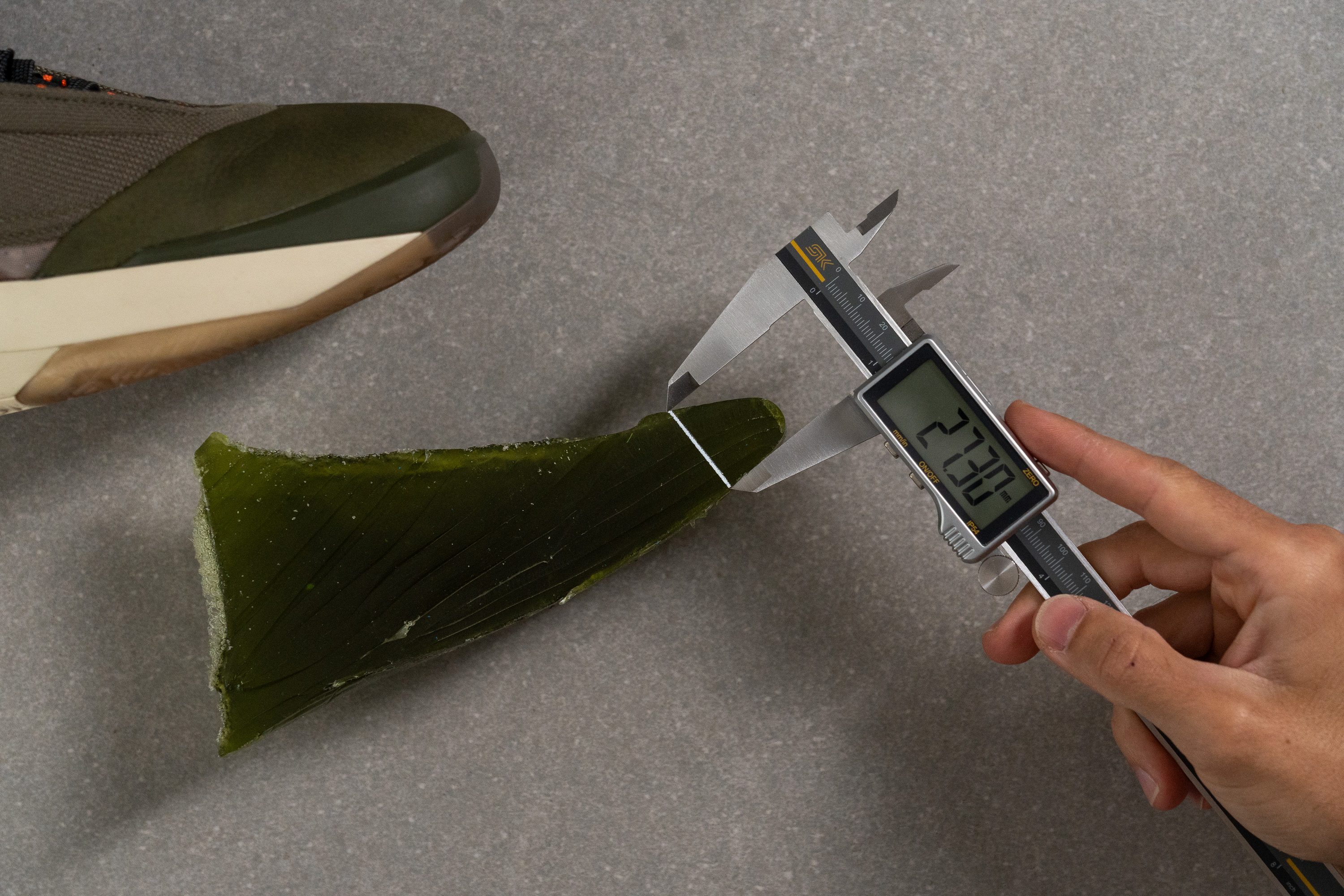
| Air 40 | 27.3 mm |
| Average | 23.5 mm |
Traction / Grip
Forefoot traction
The high energy return of this AJ iteration made jump shots, sprints, and directional bursts feel effortless, while its fabulous outsole traction made them safe and effective!
We have nothing but praise for the shoe's gripping capacity on hardwood. Measuring its friction coefficient on a professional court flooring, we got a high-end reading of 0.80.
| Air 40 | 0.80 |
| Average | 0.75 |
Outsole design
This Air Jordan mixes regular rubber with a translucent compound to get the best of both worlds. It also features a unique traction pattern with 40-degree-angle lines that accommodate hard stops and quick cuts in any direction.
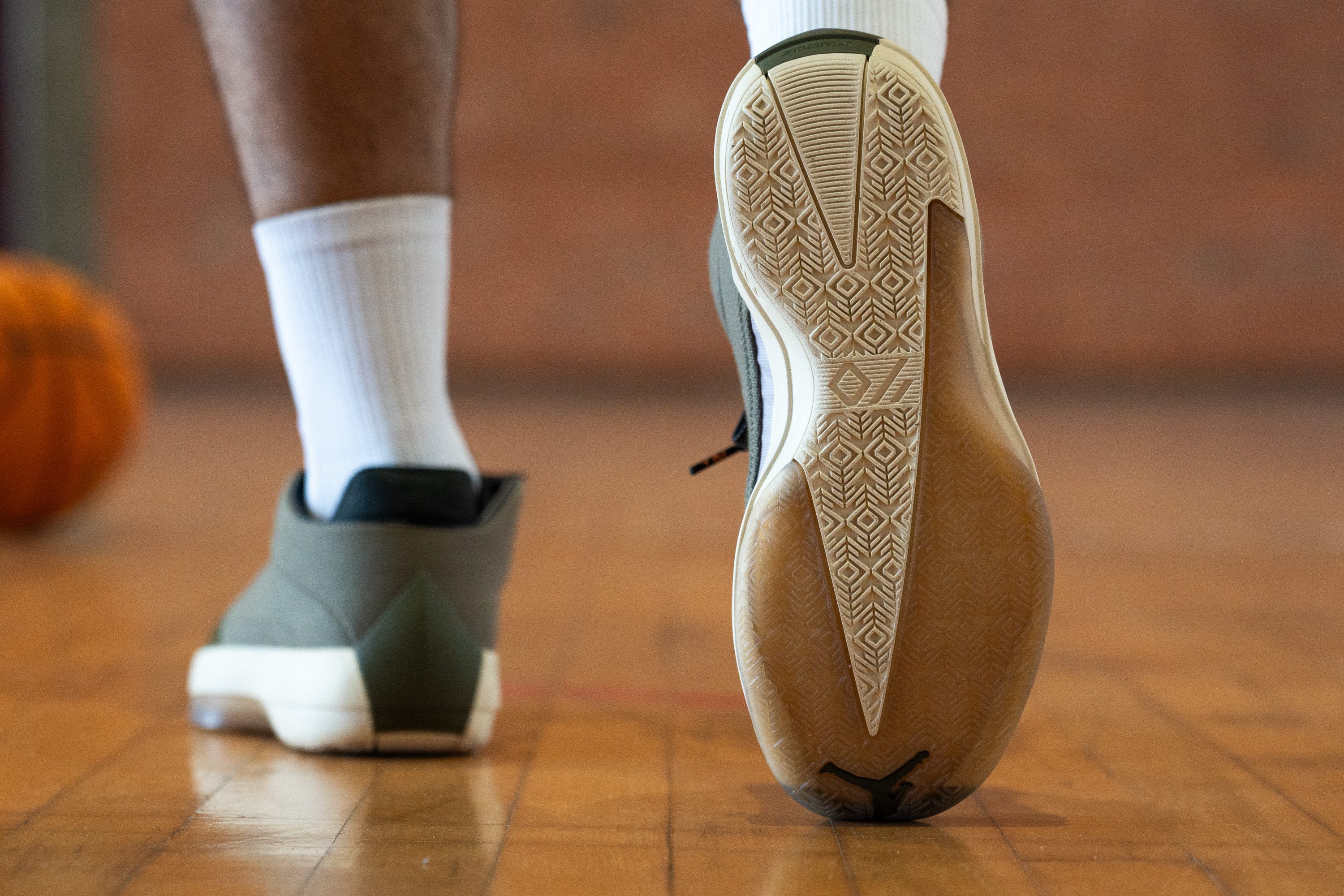
Flexibility / Stiffness
Its tough upper materials and firm rubber midsole caging didn't make the Air Jordan 40 any stiffer than the average basketball shoe.
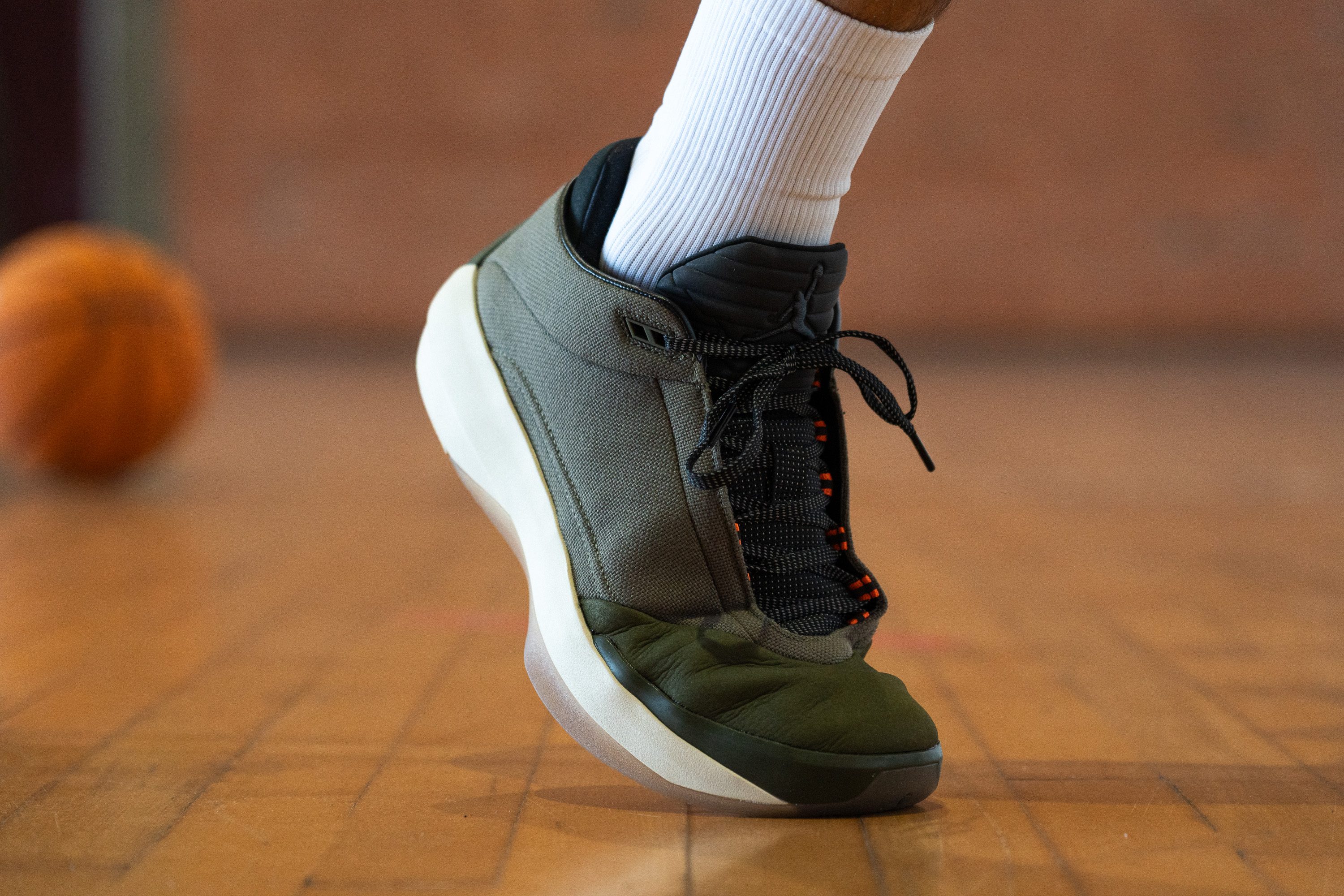
Requiring a standard amount of force to bend by 30 degrees (20.7N), the AJ40 doesn't restrict the movement and feels controllably flexible. It bends just enough to keep the ride comfortable, but still feels very much structured and supportive.
The stiffness also helps the shoe be more effective with energy transfer, cooperating with its high-rebound midsole.
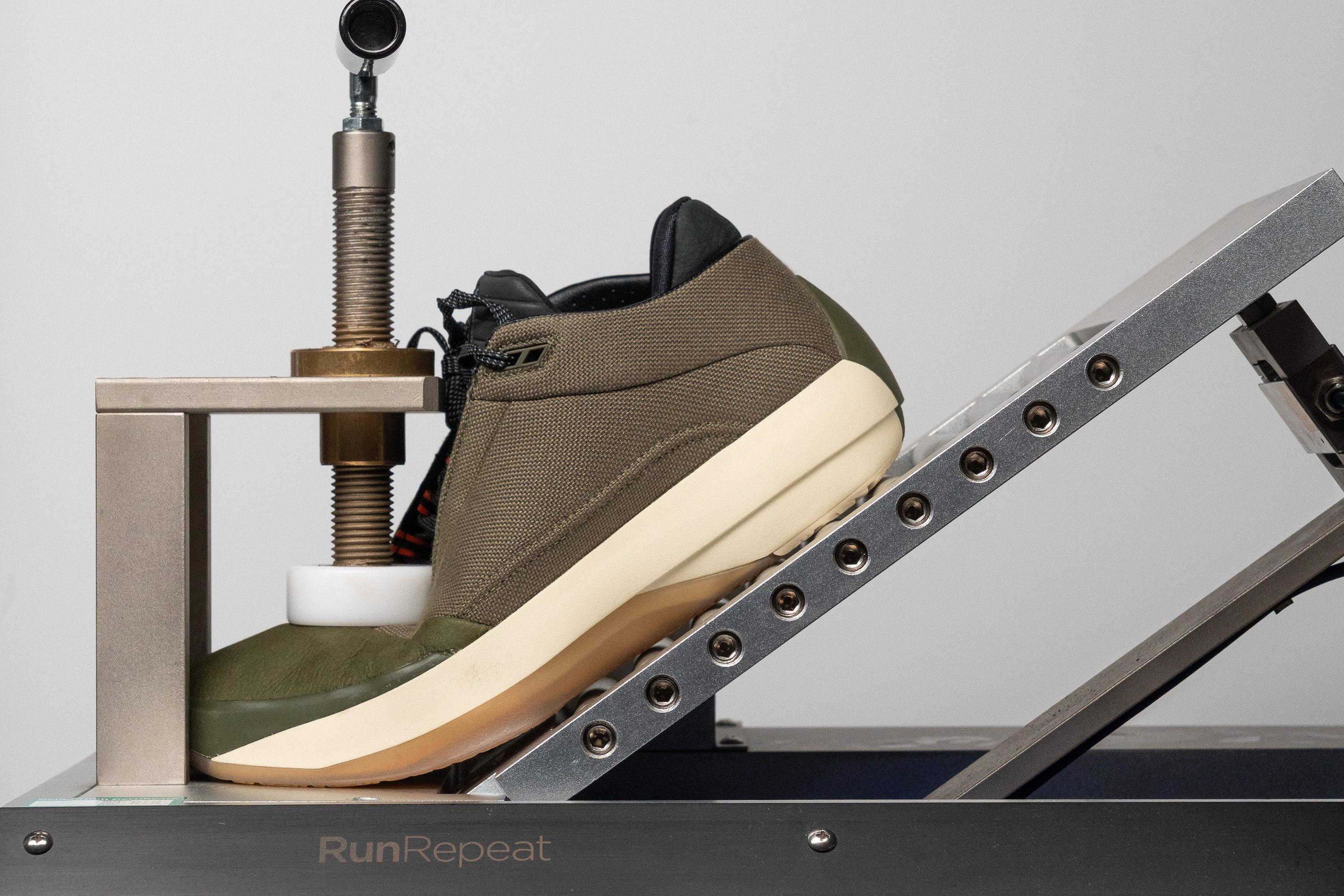
| Air 40 | 20.7N |
| Average | 20.5N |
Weight
Even with all the tweaks, tricks, and technological updates, Nike couldn't prevent the 40th Air Jordan from becoming one of the heaviest basketball shoes alongside the Nike LeBron 23. Both shoes tipped the scale at an unapologetically heavy weight of 15.5 oz (439g).
This also means that the 40 gained some serious weight from the AJ39 (1.6 oz more, to be precise).
But on a positive note, we didn't feel like this Air Jordan shoe dragged the foot down courtesy of its responsive nature.

| Air 40 | 15.5 oz (439g) |
| Average | 13.8 oz (391g) |
Breathability
The Air Jordan 40 instantly proved to be one of the toastiest basketball shoes in our lab! And, frankly, it looks that way, too.
We could see how hard the smoke tried to escape the shoe through the gaps in its tongue area, but it had little success.
This is a bulletproof Jordan shoe that can get your feet sweaty pretty quickly, especially in hot and humid weather.

The small ventilation panel in the shoe's midfoot area didn't help the situation either.

On a 1-5 breathability scale, that's an obvious 1.
| Air 40 | 1 |
| Average | 2.5 |
Stability
Lateral stability test
We were relieved and delighted to see that the Air Jordan designers revised the AJ39's stability faults and seriously leveled up the AJ40's lateral support.
The new release feels amazingly stable and supportive from the ground up! Its low-stack platform, tough rubber sidewalls, secure heel, and midfoot containment all work together to minimize the risk of ankle rolling during quick cuts, crossovers, and landings.
The shoe’s upper support deserves special attention as it features six pairs of webbed straps that connect the lacing system to the base of the shoe. These are not the frail kind of webbed eyelets that snap at first chance. Thick and sturdy, they help to keep the foot in place like safety belts in a race car.
We also took note of the shoe's asymmetrical ankle collar, which rises higher on the medial side, adding a bit more ankle coverage.
Torsional rigidity
The features listed above, as well as the shoe's thick and stout materials themselves, create a lot of torsional rigidity in the AJ40.
Not being able to twist the shoe in our manual test convinced us to rate its stiffness with the highest possible score - 5/5. Nothing like the floppy mess that the previous Air Jordan was!
| Air 40 | 5 |
| Average | 4.5 |
Heel counter stiffness
The shoe's heel counter also proved to be practically unyielding, packing both an internal plastic heel cup and a huge diamond-shaped TPU piece on the outside.
Assessing its stiffness on a 1-5 scale, we didn't hesitate to rate it high at 4/5.
| Air 40 | 4 |
| Average | 3.8 |
Midsole width - forefoot
The Air Jordan 40 proved to have a more streamlined silhouette than the Nike LeBron 23, which can be traced in its midsole dimensions.
Measuring the widest part of the shoe's midsole in the forefoot, we got a moderate caliper reading of 112.8 mm. It is a bit slimmer than average, but still broad enough to form reliable outriggers on both lateral and medial sides.
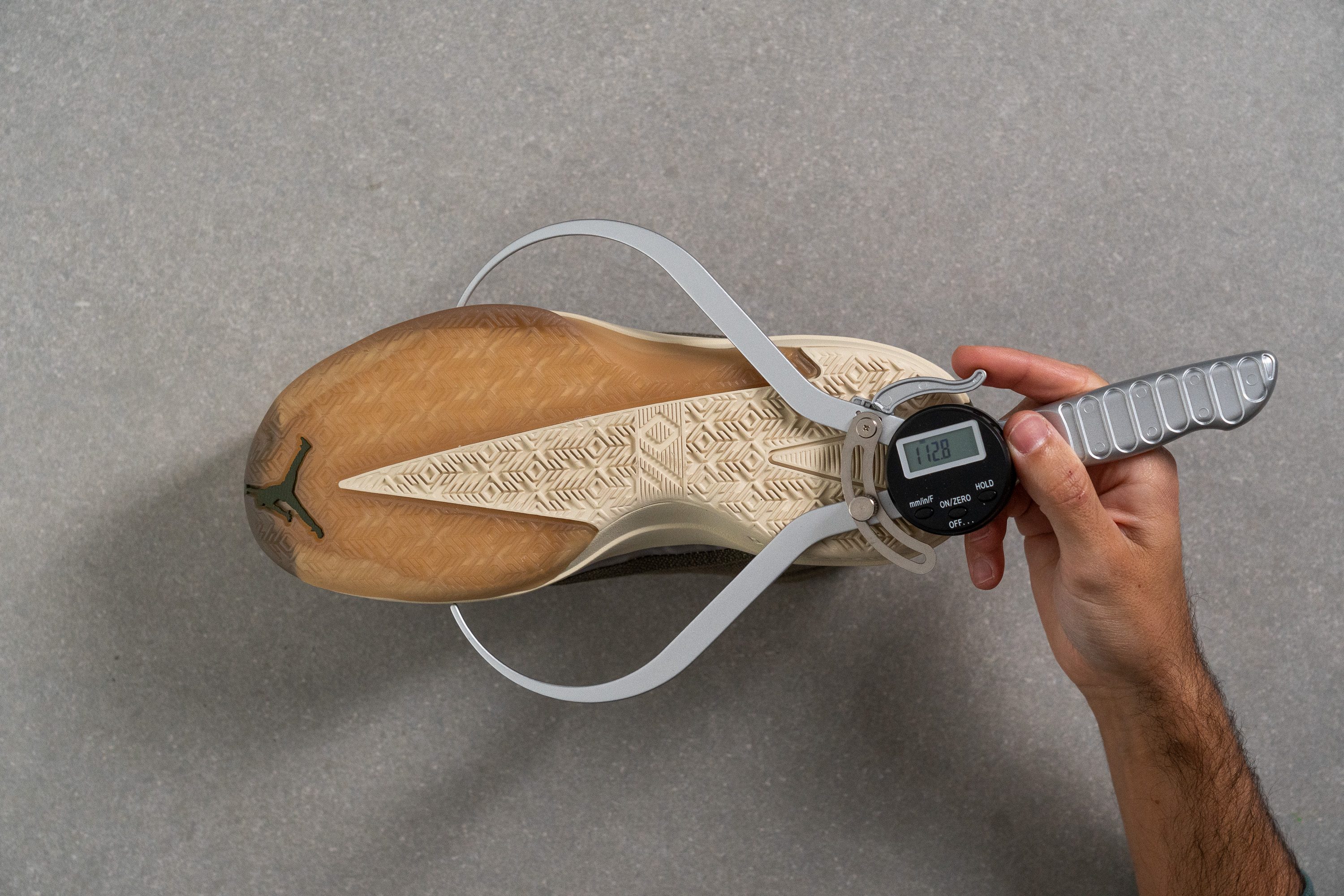
| Air 40 | 112.8 mm |
| Average | 114.8 mm |
Midsole width - heel
The heel, on the other hand, is quite narrow. At only 84.2 mm, it is similar to the nimble Nike G. T. Cut 3.
If you need those extra millimeters for more extended contact points on the court, you might prefer the Nike LeBron 23 instead.

| Air 40 | 84.2 mm |
| Average | 89.7 mm |
Durability
Toebox durability
It may give off some aged leather vibes, but the toebox material of the AJ40 is far from being frail.
Sustaining a 12-second Dremel session like a pro, it showed very minor damage, earning the shoe's toebox durability a high score of 4/5.
| Air 40 | 4 |
| Average | 3.7 |
Heel padding durability
You can also rest assured that the shoe's interior lining will serve you long and well.
Showing practically no wear and tear after the Dremel test, we granted the shoe the highest heel padding durability score of 5/5.
| Air 40 | 5 |
| Average | 3.7 |
Outsole durability
We also applied the sandpaper tip of our Dremel to the AJ40's outsole rubber for 18 seconds.
With a moderate dent of 1.1 mm, the blend proved to be nice and hard-wearing for a standard basketball shoe. But we expected slightly better results from the brand's most expensive offering, to be honest.
| Air 40 | 1.1 mm |
| Average | 1.0 mm |
Outsole thickness
With a caliper reading of 4.0 mm, the AJ40's outsole thickness earned our nod of approval. It is a perfect amount of rubber for an indoor hoop shoe.
But do we recommend this option for outdoor courts? We wouldn't risk it at this price point because we have concerns about the longevity of its thin treadlines on the blacktop.
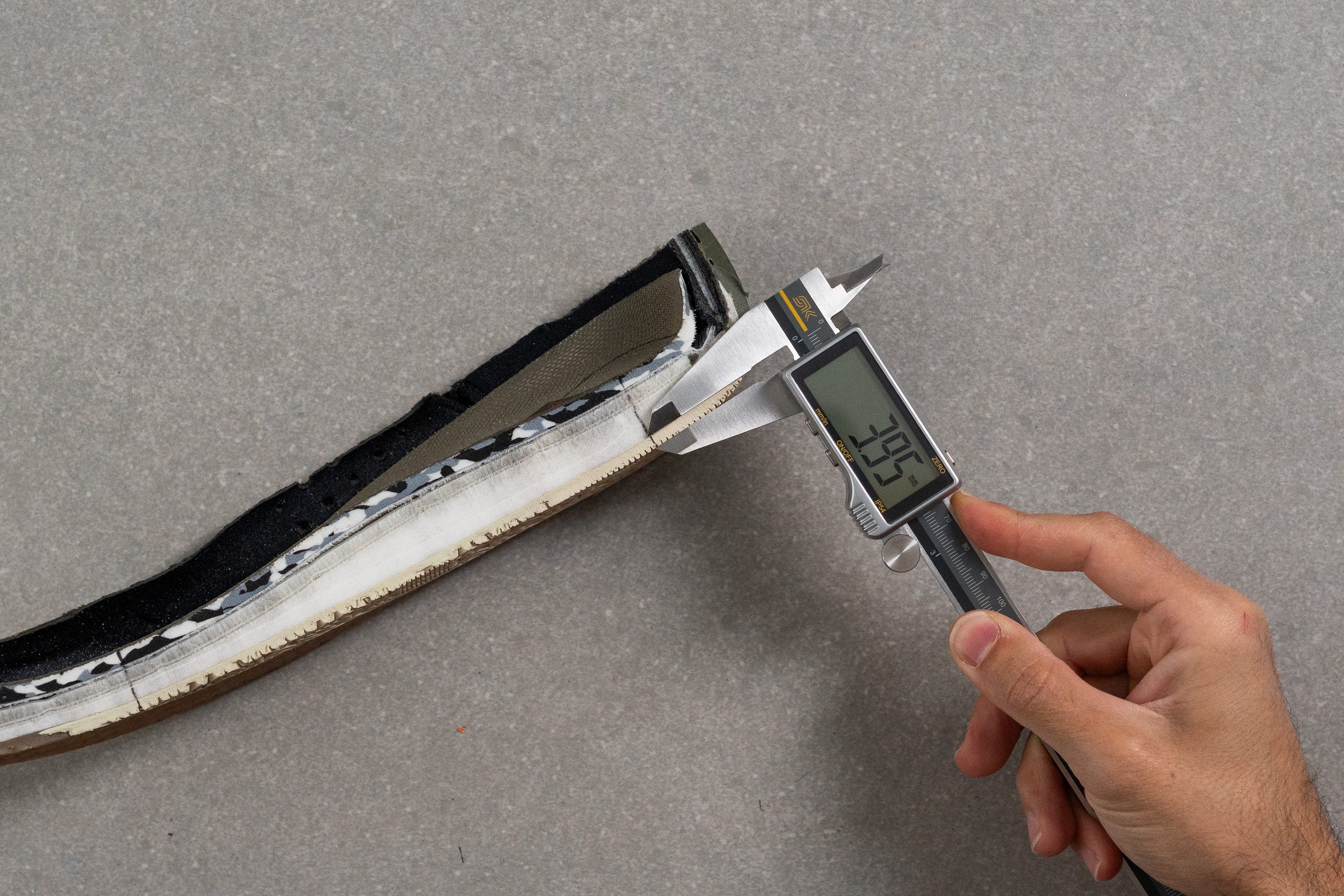
| Air 40 | 4.0 mm |
| Average | 4.0 mm |
Misc
Insole thickness
The Air Jordan 40 packs a comfortable and well-padded insole. We recorded its thickness at a standard 4.6 mm in the heel area.
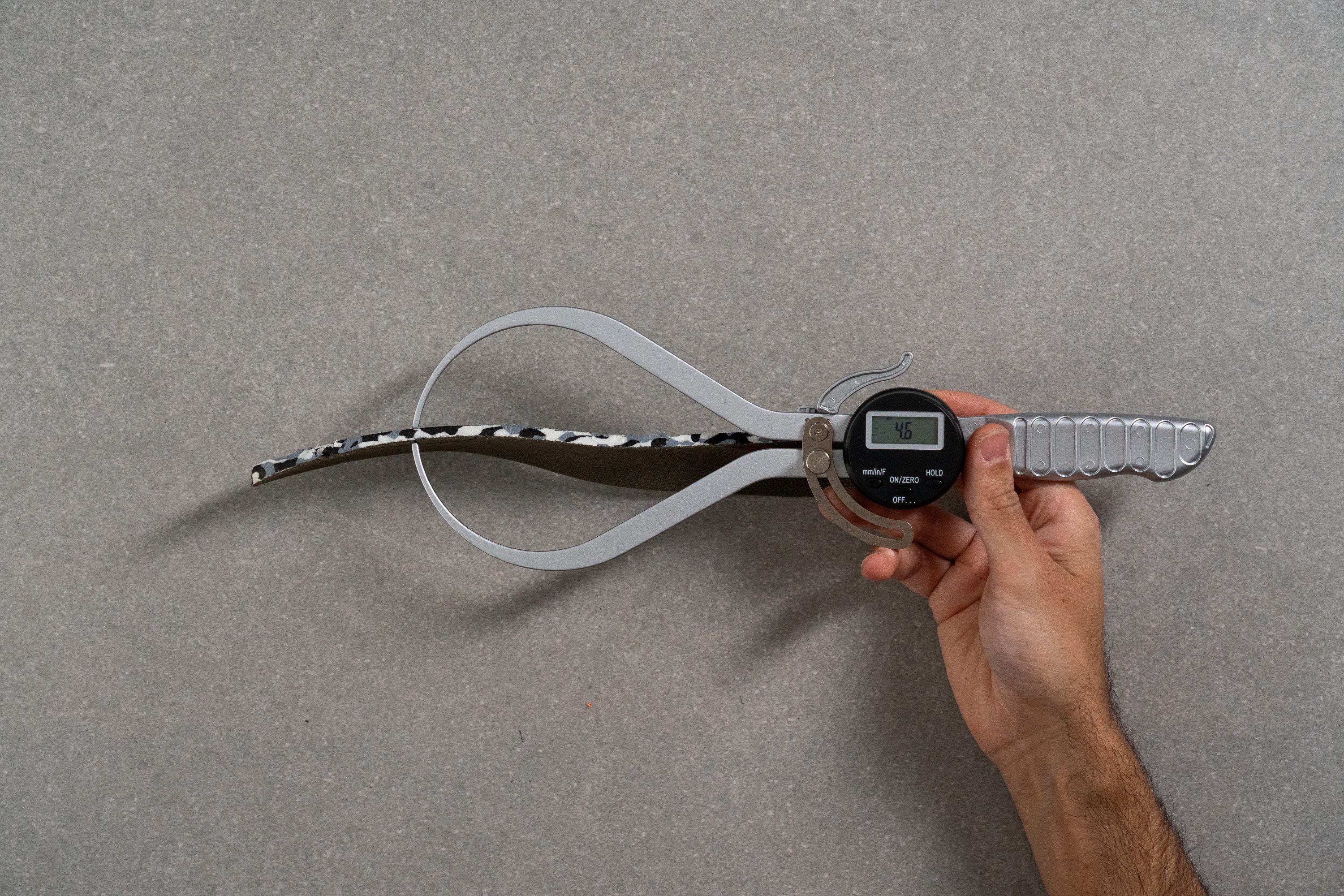
| Air 40 | 4.6 mm |
| Average | 4.9 mm |
Removable insole
The shoe's insole is removable, so you can potentially opt for a custom orthotic.
But as the photo below shows, the insole sits right on top of the shoe's Zoom Strobel, working together with it and the ZoomX foam to maintain that high level of energy return. Replacing the insole can alter the AJ40's underfoot experience a lot.
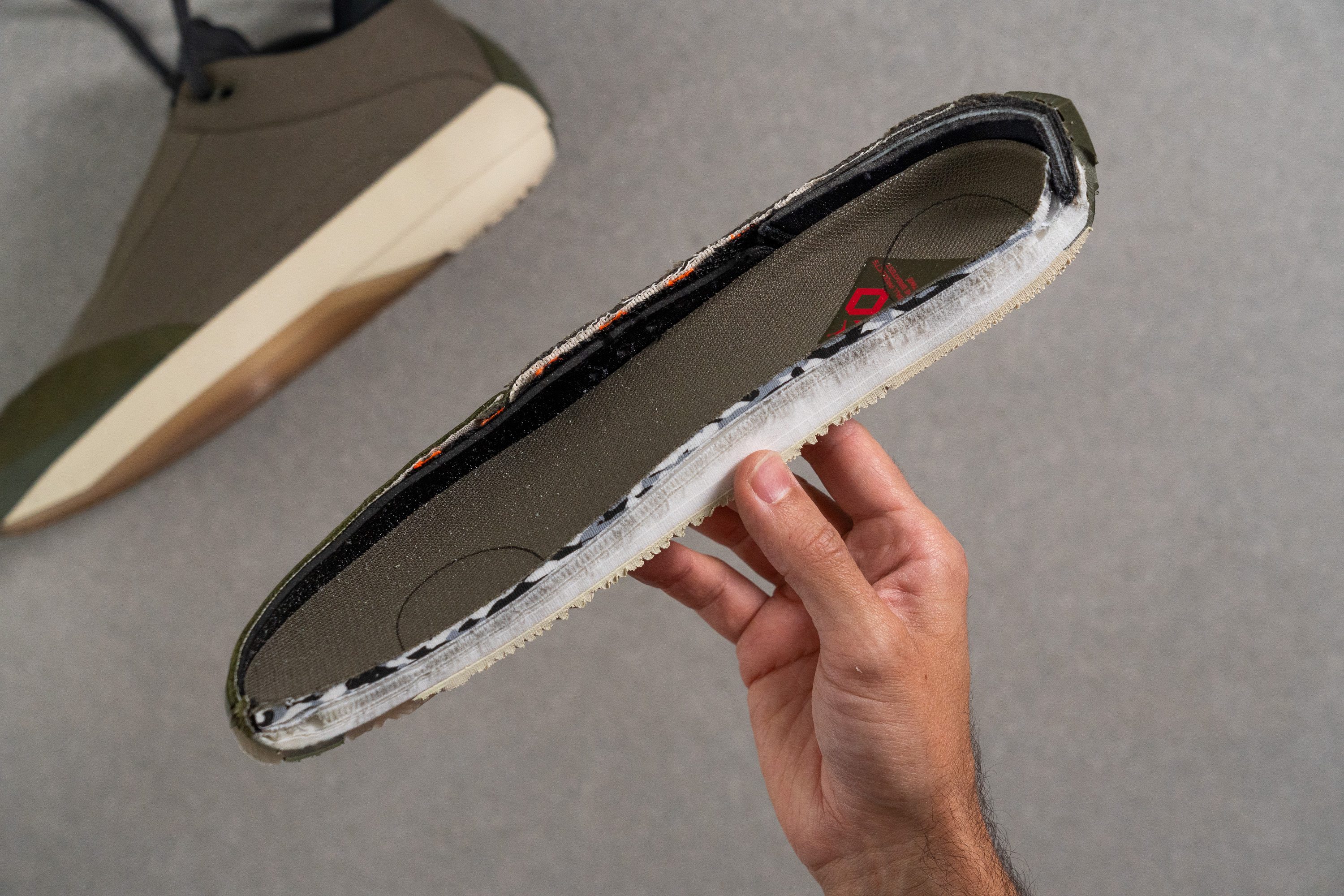
| Air 40 | Yes |
Reflective elements
Taking the shoe through our dark room test, we found the webbing in its laces to be reflective.
| Air 40 | Yes |
Tongue padding
The interior padding is not as abundant in the Air Jordan 40 as it is in the Nike LeBron 23. But the amount of foam is ample enough to ensure comfort and a secure foothold.
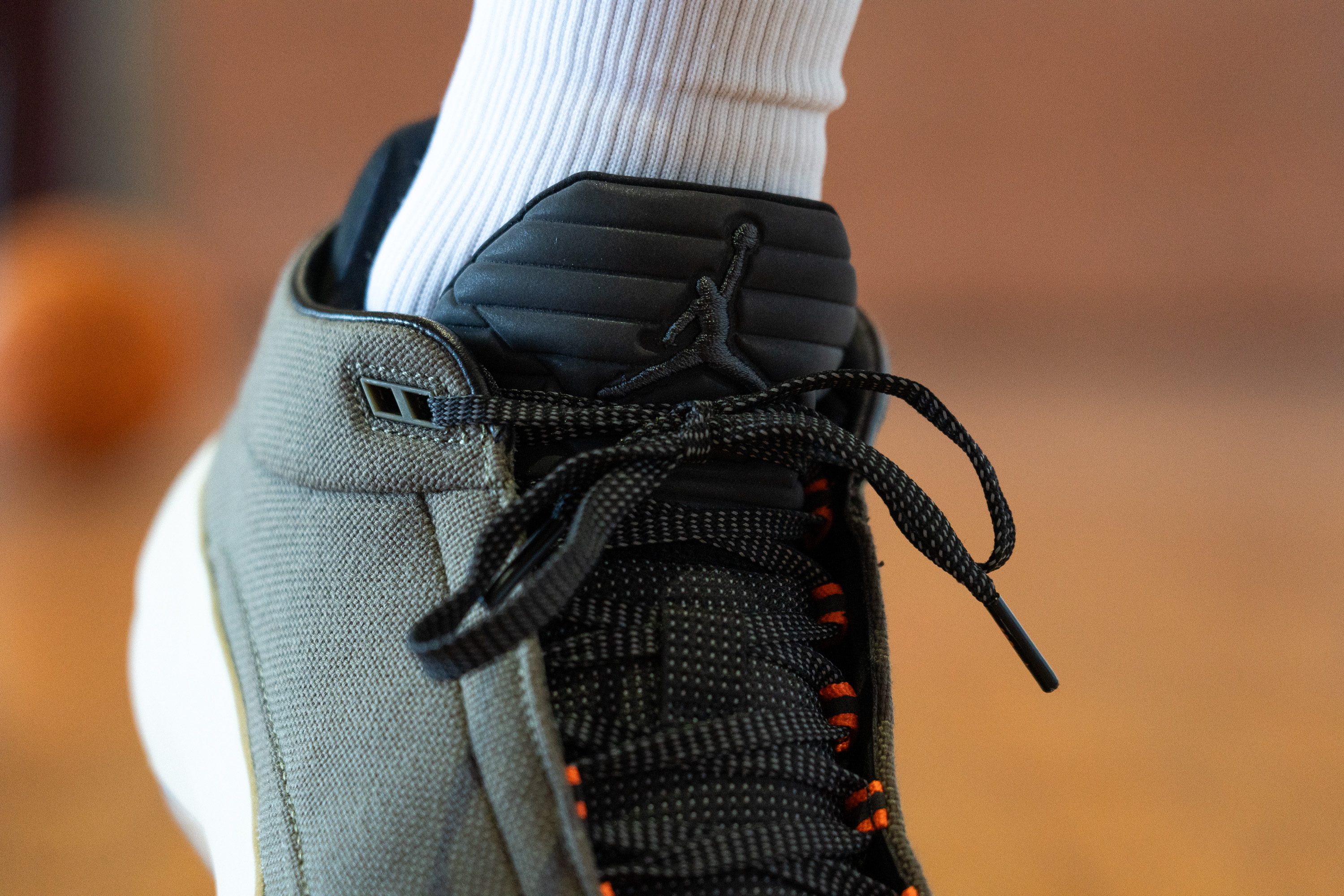
We measured its padding thickness at 7.5 mm. It is slightly thinner than average but foamy enough to keep lace bites at bay.

| Air 40 | 7.5 mm |
| Average | 9.3 mm |
Tongue: gusset type
A fully-gusseted tongue complements the midfoot strap system to ensure the most secure foot containment.
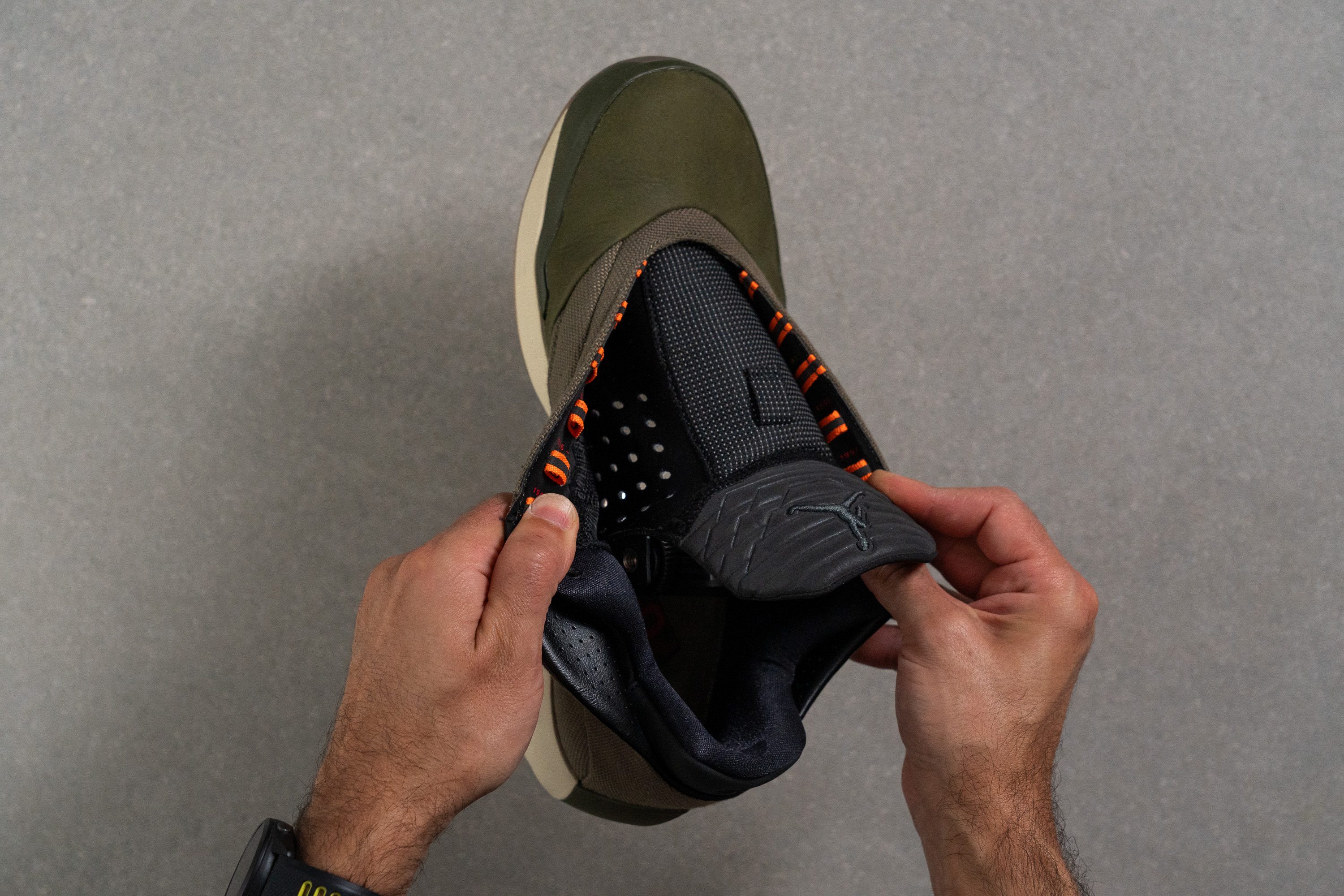
| Air 40 | Both sides (full) |
Price
As Nike/Jordan's second most expensive basketball shoe (after the LeBron 23), the Air Jordan 40 justifies its price point by employing the brand's most cutting-edge technologies (ZoomX cushioning foam) and top-tier materials overall.
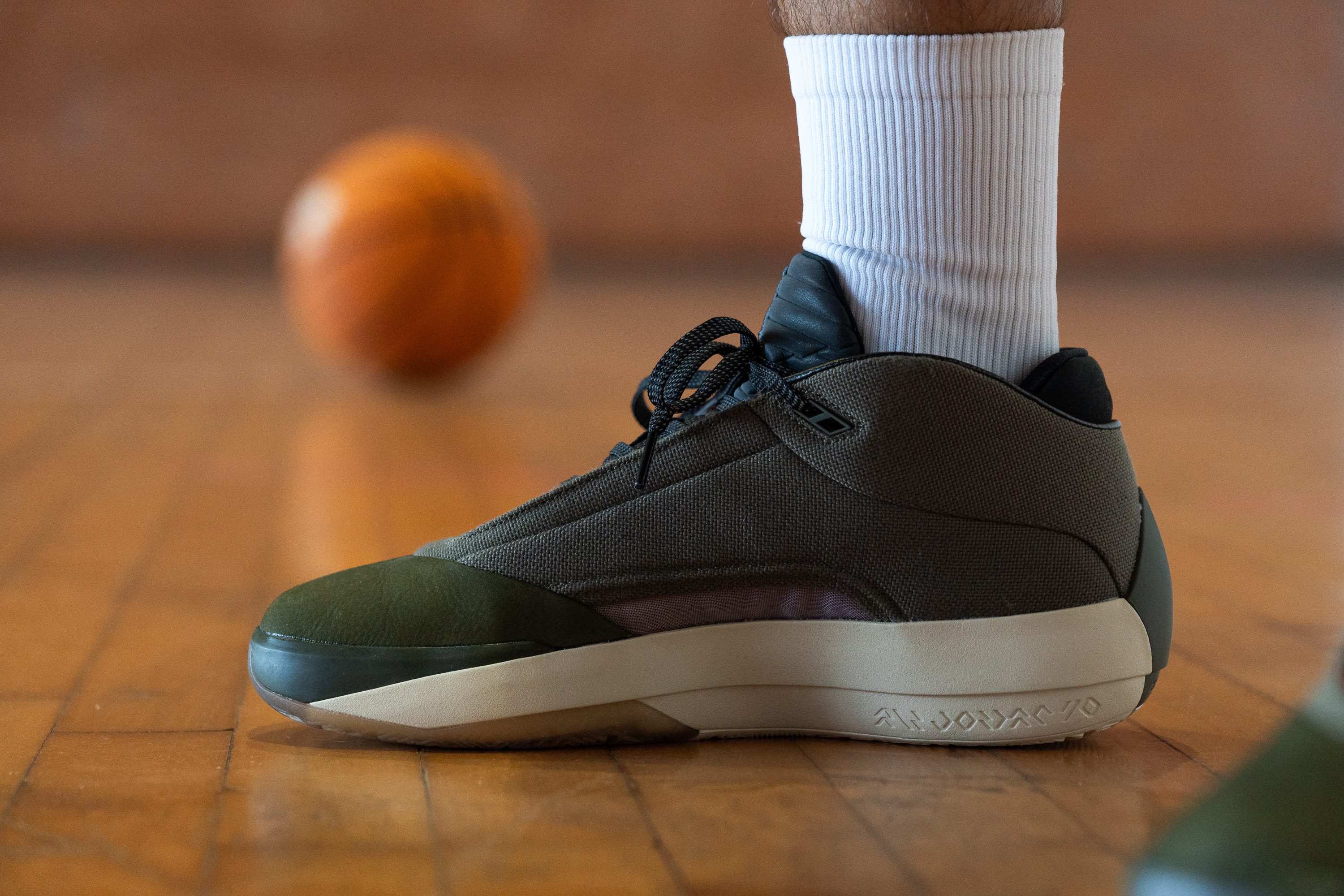
| Air 40 | $205 |
| Average | $136 |
Heel tab
The shoe has no finger loops or pull tabs, but the back of its collar is extended and can assist in getting the shoe on.
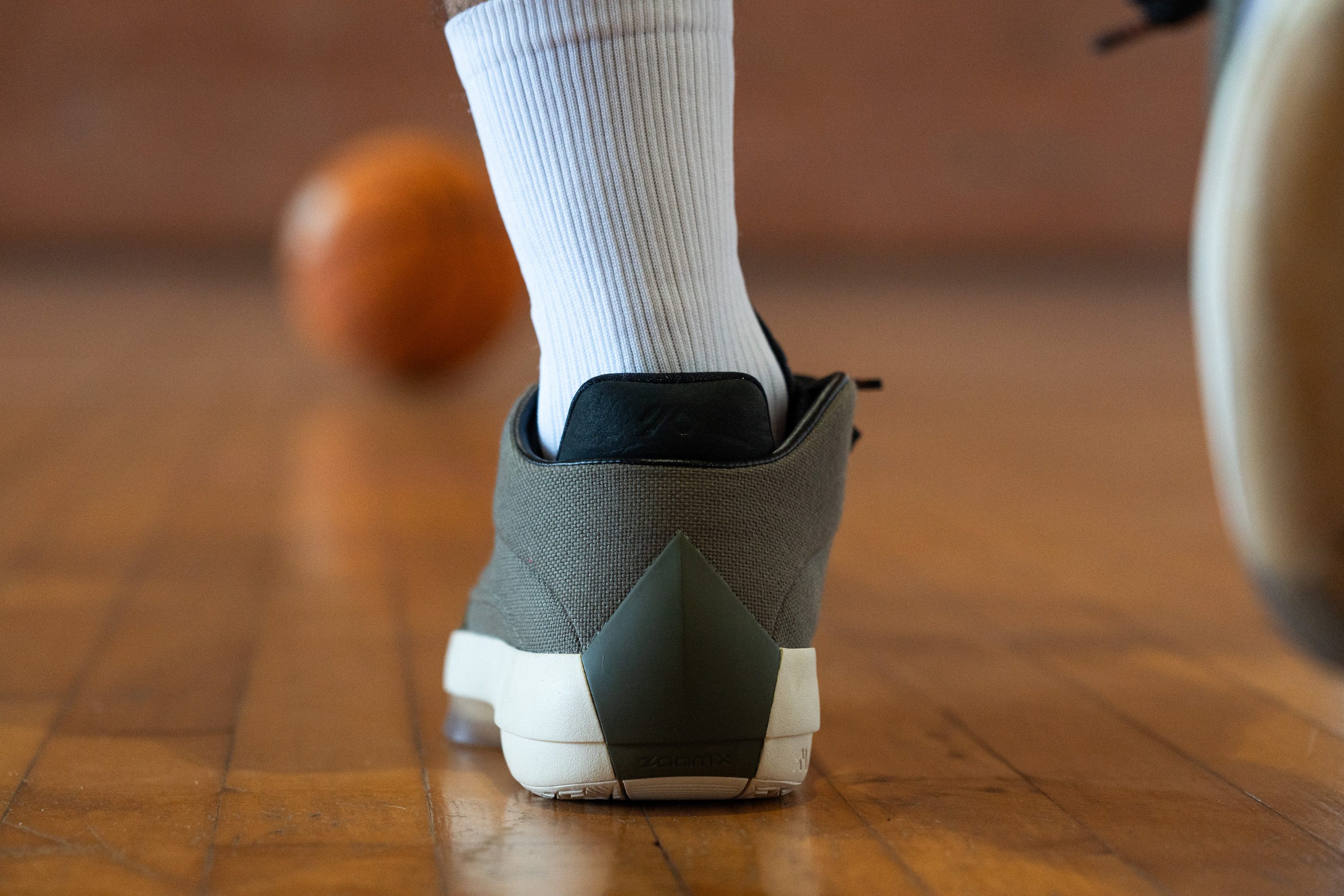
| Air 40 | None |




















































